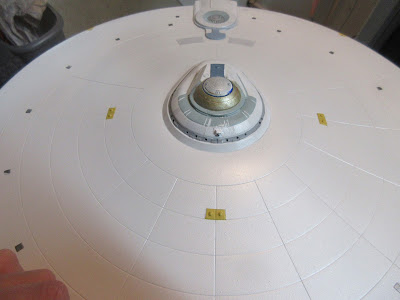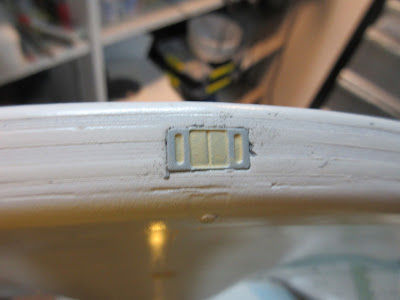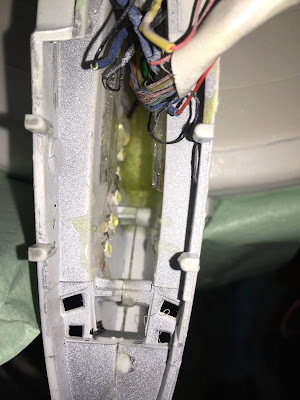This entry will cover my fixes to the secondary hull to get it ready to be mated with the saucer and neck.
The first issue to fix is where I left off, the shuttlebay. There was a lot of bleeding through the tape, so I had to repaint it in sections.
I still have to retouch the angular grey sections due to overspray.
Next step was to paint the phaser banks. I painted them from the same batch of paint I used on the saucer's RCS thruster and phasers. (I also painted them at the same time as I painted the saucer's phaser banks and deflector dish - from a future update, so as to not waste paint from transferring back and forth from the reservoir for the airbrush and the mixed solution.)
 |
| ventral phasers on the belly of the engineering hull |
 |
| just over the shuttle bay |
And the reveal...
Next step was to touch up on the strong back details. The strong back is painted a light grey made by Lowe's brand of paints, Valspar. So I sprayed a card and touched up with a brush.
I then ran a black micro Sharpie in the grooves between the rings around the grooves of the deflector housing.
PYLON FIX
As I previously mentioned in a previous update, the tip of the pylon busted off. https://fordosmodels.blogspot.ca/2016/11/constitution-class-refit-uss-olympia.html
I have a second kit, unbuilt (actually two - one sealed, one open from 2005). I gathered the parts from the unbuilt kit in an effort to cast a mould off of the pylon.
Here is the starboard nacelle.
I mocked up the starboard nacelle and pylon with painter's tape.
I then used a two part silicon putty to make a mould off of the vents on the starboard pylon. Having the nacelle in place helped show me where to stop filling the gap with resin.
Next, I went to my stock of pipe and rods. I found a suitable steel rod to insert into the cavity of the nacelle pylon.
I used a 15 min epoxy to affix the rod to the hollow pylon.
And at the same time, I reinforced the socket for the stand in the secondary hull. I found the off-balance of the secondary hull was causing the connection to weaken. This is a heavy model and the last I thing I want to have happen is for the model to topple over. Epoxy resin is very strong, adheres well and tough to get off... trust me on this one.
 |
| sourced from the web - no copyright infringement is intended |
Ready to pour!
 |
| note, you can see the terminal connection for the future engines |
I propped up this part of the model to ensure this section of the model was 100% level. It needs to be to pour in resin.
Survey says...
Here are the results. I noticed there was a leak as the resin seemed to drain through the pylon. I put in blocks with styrene and hot glue but I guess there wasn't a perfect seal. It actually drained and leaked on the hull. Fortunately it didn't stick to the glossy surface of the paint and could be chipped off easily. The residue easily removed with mineral spirits. I tried doing that on the engraved detail on the pylon and created a bigger mess.
Moving forward, I cut off the metal rod with a dremel rotary tool.
I still need to refine the fit of the nacelle to the pylon now that the resin has fully cured.
But before I do that, I need to fix the grill work. This has been a very frustrating setback. I paint the section with grey primer to see the faults, and there were quite a few. I then had a new idea/approach, fill in the gaps with putty and stamp the design in with a half mould. I wasn't going to reuse the mould I previously made, so I made a new mould off of the unbuilt pylon.
Here is my first attempt. It's ok, but not perfect.
I then painted it, and still no go. So a few more tries later, this time filling in the whole piece.
In the end I re-stamped it and smother over the bumpiness with my finger.
That wraps up this entry...more fixing and painting on this 'beastie'. Next entry, I start the decals on the saucer!
Happy Model Building!
Star Trek and all related marks, logos and characters are solely owned by CBS Studios Inc. This fan blog (production) is not endorsed by, sponsored by, nor affiliated with CBS, Paramount Pictures, or any other Star Trek franchise, and is a non-commercial fan-made blog intended for recreational use. No commercial exhibition or distribution is permitted. No alleged independent rights will be asserted against CBS or Paramount Pictures.











































































